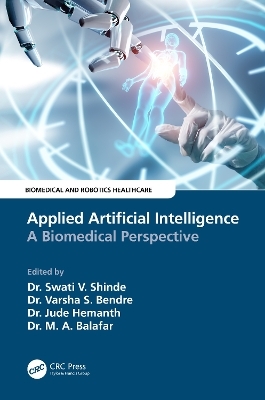
Applied Artificial Intelligence
CRC Press (Verlag)
978-1-032-34914-5 (ISBN)
This book explores the advancements and future challenges in biomedical application developments using breakthrough technologies like Artificial Intelligence (AI), Internet of Things (IoT), and Signal Processing. It will also contribute to biosensors and secure systems,and related research. Applied Artificial Intelligence: A Biomedical Perspective begins by detailing recent trends and challenges of applied artificial intelligence in biomedical systems.
Part I of the book presents the technological background of the book in terms of applied artificial intelligence in the biomedical domain. Part II demonstrates the recent advancements in automated medical image analysis that have opened ample research opportunities in the applications of deep learning to different diseases. Part III focuses on the use of cyberphysical systems that facilitates computing anywhere by using medical IoT and biosensors and the numerous applications of this technology in the healthcare domain. Part IV describes the different signal processing applications in the healthcare domain. It also includes the prediction of some human diseases based on the inputs in signal format. Part V highlights the scope and applications of biosensors and security aspects of biomedical images.
The book will be beneficial to the researchers, industry persons, faculty, and students working in biomedical applications of computer science and electronics engineering. It will also be a useful resource for teaching courses like AI/ML, medical IoT, signal processing, biomedical engineering, and medical image analysis.
Dr. Swati V. Shinde has a Ph.D. in Computer Science and Engineering, from Swami Ramanand Teerth Marathwada University, Nanded. She has 20 years of teaching experience and is currently working as a Professor at Pimpri Chinchwad College of Engineering (PCCoE), Pune. She has worked as a HOD-IT for seven years in PCCoE. Her research interests include Machine Learning, Deep Learning, Soft Computing, Artificial Neural Network, and Fuzzy Logic. Dr. Varsha Bendre received a Bachelor’s degree in Electronics and Telecommunication Engineering from Saint Gadge Baba Amravati University, Amravati, and M.E degree from Savitribai Phule Pune University in 2000 and 2010 respectively. She completed a Ph.D. in the area of Nanotechnology and Low Power VLSI from Savitribai Phule Pune University, Pune, and Maharashtra, India in Jan 2020. Her research work is focused on analog circuit design at very deep submicron technology using Carbon Nanotube Field-Effect Transistors. Dr. D. Jude Hemanth received his B.E degree in ECE from Bharathiar University in 2002, M.E degree in communication systems from Anna University in 2006, and Ph.D. from Karunya University in 2013. His research areas include Computational Intelligence and Image processing. Dr. MA Balafar completed his Ph.D. in IT from UPM, Malaysia. He has 16 years of teaching experience and is working as an Assistant Professor at the University of Tabriz, Iran. His research interests are AI, computer vision, Fuzzy Logic, Deep Learning, Machine Learning, and information security.
1 Healthcare Fees-Centric to Value-Centric Transformation through Data, Analytics, and Artificial Intelligence
2 AI-Based Healthcare: Top Businesses and Technologies 3 Insights into AI, Machine Learning, and Deep Learning 4 Deep Learning for Visual Perceptual Brain Decoding as Image Classification 5 Automatic Brain Tumor Segmentation in Multimodal MRI Images Using Deep Learning 6 Automated Prediction of Lung Cancer Using Deep Learning Algorithms 7 Cervical Cancer Screening Approach Using AI D. Santhi, M. Carmel Sobia, and M. Jayalakshmi 8 Progression Detection of Multiple Sclerosis in Brain MRI Images 9 Artificial Intelligence Clustering Techniques on Dermoscopic Skin Lesion Images 10 Automated Alzheimer’s Disease Detection with Optimized Fuzzy Neural Network 11 A Comprehensive Survey with Bibliometric Analysis on Recent Research Opportunities of Multimodal Medical Image Fusion in Various Applications 12 Big Data in IoT for Healthcare Application 13 Automatic Detection of Diabetic Retinopathy to Avoid Blindness 14 A Review on Wireless BAN to Measure the Respiration Rate Using SoC Architecture 15 Deep Feature Extraction for EEG Signal Classification in Motor Imagery Tasks 16 Effect of Age in Normal Women by Heart Rate Variability Analysis
17 EEG Signal Analysis Using Machine Learning and Artificial Intelligence for Identification of Brain Dysfunction
18 Cervical Cancer Screening Methods: Comprehensive Survey 19 Understanding Assessment Methods and Sensors for ADHD Hyperactive-Impulsive Type among Children 20 Security of Medical Image Information by Cryptography and Watermarking Using Python 21 Integration of Biosensors and Drug Delivery Systems for Biomedical Applications 22 Automatic Liver and Lesion Segmentation in CT Using 3-D Context Convolutional Neural Network: 3-D Context U-Net
| Erscheinungsdatum | 03.10.2023 |
|---|---|
| Reihe/Serie | Biomedical and Robotics Healthcare |
| Zusatzinfo | 30 Line drawings, color; 12 Line drawings, black and white; 136 Halftones, color; 42 Halftones, black and white; 166 Illustrations, color; 54 Illustrations, black and white |
| Verlagsort | London |
| Sprache | englisch |
| Maße | 156 x 234 mm |
| Gewicht | 730 g |
| Themenwelt | Informatik ► Theorie / Studium ► Algorithmen |
| Informatik ► Theorie / Studium ► Künstliche Intelligenz / Robotik | |
| Medizin / Pharmazie ► Physiotherapie / Ergotherapie ► Orthopädie | |
| Technik ► Medizintechnik | |
| Technik ► Umwelttechnik / Biotechnologie | |
| ISBN-10 | 1-032-34914-X / 103234914X |
| ISBN-13 | 978-1-032-34914-5 / 9781032349145 |
| Zustand | Neuware |
| Haben Sie eine Frage zum Produkt? |
aus dem Bereich


